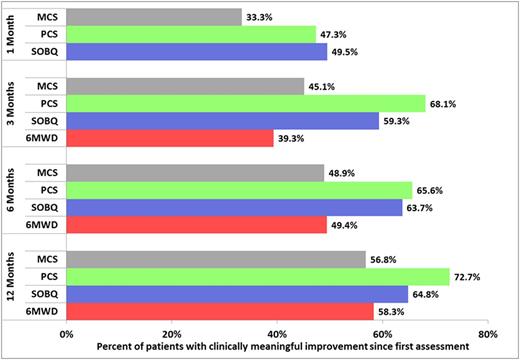Abstract
Background: Most research on prognosis after PE has focused on outcomes such as mortality and PE recurrence, while patient-centered outcomes such as quality of life (QOL), dyspnea and walking capacity have been largely unstudied. To address this knowledge gap, we performed the ELOPE (Evaluation of Longterm Outcomes after PE) study, a prospective, observational, multicenter cohort study of long-term outcomes after acute PE (www.clinicaltrials.gov NCT01174628).
Objectives: In this extended analysis of ELOPE data, we assessed clinically meaningful improvement and predictors of change in QOL, dyspnea and walking capacity during the year following PE diagnosis.
Methods: Patients aged 18 years or older with a 1st episode of acute PE diagnosed within the previous 10 days screened at 5 Canadian recruiting centers were potentially eligible to participate. Exclusion criteria were subsegmental-only PE, preexisting severe cardiopulmonary comorbidity, previous proximal DVT, contraindication to CT pulmonary angiography, life expectancy <1 year, unable to read questionnaire in English and French or to attend follow-up visits, and unable or unwilling to consent. At baseline, 1, 3, 6 and 12 months after PE, we measured generic QOL (SF-36 PCS and MCS), PE-specific QOL (PEmbQoL), dyspnea (UCSD Shortness of Breath Questionnaire [SOBQ]), and walking capacity (6-minute walk distance (6MWD); not measured at baseline). The proportion of patients who exhibited at least 1 unit of clinically meaningful improvement (CMI) in a given measure from the first assessment to the 1 year assessment was calculated (based on the available literature, at least a 4 point change in PCS and MCS scores, a 5 point change in SOBQ score, and a 30 meter increase in 6MWD represented one unit of CMI). Predictors of change in generic QOL, PE-specific QOL, dyspnea, and 6MWD during follow-up were analyzed by repeated-measures mixed effects models.
Results: 984 patients were screened for participation; of these, 150 were eligible and 100 (67%) consented to participate. Mean (SD) age was 50 (15) years, 57% were male, 80% were outpatients and 33% had concomitant DVT. PE was provoked in 21% and unprovoked in 79%; none were cancer-related. Figure shows percent of patients with clinically meaningful improvement during follow-up, compared to the first assessment. Statistically significant independent predictors of worse evolution over time included female sex and percent-predicted VO2 peak <80% on 1 month cardiopulmonary exercise test for all outcomes, prior lung disease and higher pulmonary artery systolic pressure on 10-day echocardiogram for SF-36 PCS and dyspnea outcomes, and higher main pulmonary diameter on baseline CTPA for PEmb-QoL outcome. Modeling results after multiple imputation were similar to those using available data.
Conclusions: Most patients showed clinically meaningful improvement in QOL, dyspnea and walking distance during 1 year follow-up. However, a number of clinical and physiological predictors of worse outcome over time were identified. These results provide new information on prognosis after PE.
Funding: Canadian Institutes of Health Research (MOP-93627)
SF-36 PCS, SF-36 MCS, SOBQ, and 6MWD were measured at Baseline (except 6MWD), 1, 3, 6, and 12 months after acute PE.
Clinically meaningful improvement in QOL, dyspnea scores and walking distance during follow-up, compared to the first assessment.
Clinically meaningful improvement in QOL, dyspnea scores and walking distance during follow-up, compared to the first assessment.
No relevant conflicts of interest to declare.
Author notes
Asterisk with author names denotes non-ASH members.


This feature is available to Subscribers Only
Sign In or Create an Account Close Modal